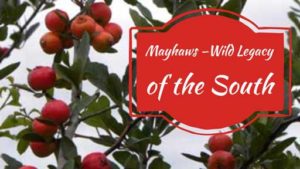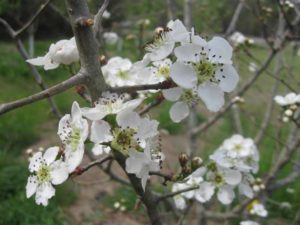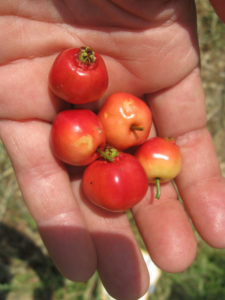 There are few fruits and can be claimed as regional. Mayhaws are one of the few. Found only growing in the swamps and on the river banks of the states of Florida, Georgia, Alabama, Mississippi, and East Texas, the mayhaw has been one of the best kept secrets of the south. The jelly made from this wild fruit is hard to describe-like sweet cherries mixed with pineapple and mango. It’s a rare combination for something that grows with no care.
There are few fruits and can be claimed as regional. Mayhaws are one of the few. Found only growing in the swamps and on the river banks of the states of Florida, Georgia, Alabama, Mississippi, and East Texas, the mayhaw has been one of the best kept secrets of the south. The jelly made from this wild fruit is hard to describe-like sweet cherries mixed with pineapple and mango. It’s a rare combination for something that grows with no care.
Gathering this fruit in the wild is quite the adventure. It ripens in late spring, often when the river banks and swamps are swollen with the rains of winter. If you want to get some, take a boat and a fine meshed minnow net. The fruit that drops from the tree is buoyant and floats. Follow the trail of floating mayhaws until you reach the source, shake the tree and skim the red berries off the water with your minnow net.
 If you’d rather not battle the snakes and bugs, you can grow your own mayhaws. Contrary to where they are found growing in the woods, mayhaws will grow well in any good garden plot. They love the edges of wood lines, old pastures, and unused areas of your vegetable garden. The trees are small, rarely growing larger than 15 feet. They are quite attractive when in fruit and flower. They are really something to think about adding to your edible landscape. Like plums, they look best when planted in groups or three to five in the landscape. This will give you a beautiful show in spring and summer when they are flowering and fruiting, as well as take care of the pollination requirements. Some varieties bloom earlier than others so you will need to match your varieties for good cross pollination. Here’s a breakdown on the planting groups:Early flowering Marleen and Betsy need to be planted together. Late bloomers that need to be planted together are Reliable, Maxine, Big Red, and Georgia Gem.
If you’d rather not battle the snakes and bugs, you can grow your own mayhaws. Contrary to where they are found growing in the woods, mayhaws will grow well in any good garden plot. They love the edges of wood lines, old pastures, and unused areas of your vegetable garden. The trees are small, rarely growing larger than 15 feet. They are quite attractive when in fruit and flower. They are really something to think about adding to your edible landscape. Like plums, they look best when planted in groups or three to five in the landscape. This will give you a beautiful show in spring and summer when they are flowering and fruiting, as well as take care of the pollination requirements. Some varieties bloom earlier than others so you will need to match your varieties for good cross pollination. Here’s a breakdown on the planting groups:Early flowering Marleen and Betsy need to be planted together. Late bloomers that need to be planted together are Reliable, Maxine, Big Red, and Georgia Gem.
Grow the trees much like you would plums. Add manure when planting and fertilize regularly. Although they will grow and fruit in light shade, it’s best to plant them in sunny areas. . They are relatively pest free, (coming from the wild does have those advantages). To read in-depth how to grow mayhaws check out our “Mayhaw Planting and Care†guide. They are easy to grow and a great choice for organic gardeners and permaculture food plots or edible forests
 Harvesting the fruit is an easy task, like mulberries you can place a clean piece of plastic under the tree and shake the trees. Gather up the four corner of the plastic and pour the fruit into a bucket. It’s super easy.
Harvesting the fruit is an easy task, like mulberries you can place a clean piece of plastic under the tree and shake the trees. Gather up the four corner of the plastic and pour the fruit into a bucket. It’s super easy.
Although the fruit is used most often used to make jellies, the juice and a syrup made from the juice is easier to deal with. It’s much more versatile to use in cooking and can be frozen for later use. The juice is great mixed with other fruit juices for making smoothies and mixed cocktails. The syrup made from boiling the juice down is delicious on pancakes and in meat glazes.
For a great resource on making mayhaw jelly and syrup as well as easy recipes that use mayhaw juice and syrup, read LSU publication “The Mayhaw-Out of the Swamp into the Orchardâ€.  Â
[fblike url=”https://justfruitsandexotics.com/mayhaws-wild-legacy-of-the-south/” style=”standard” showfaces=”false” width=”450″ verb=”like” font=”arial”]

